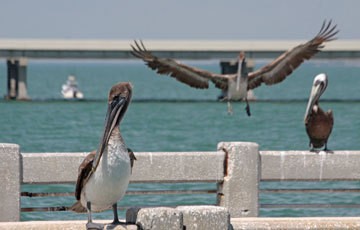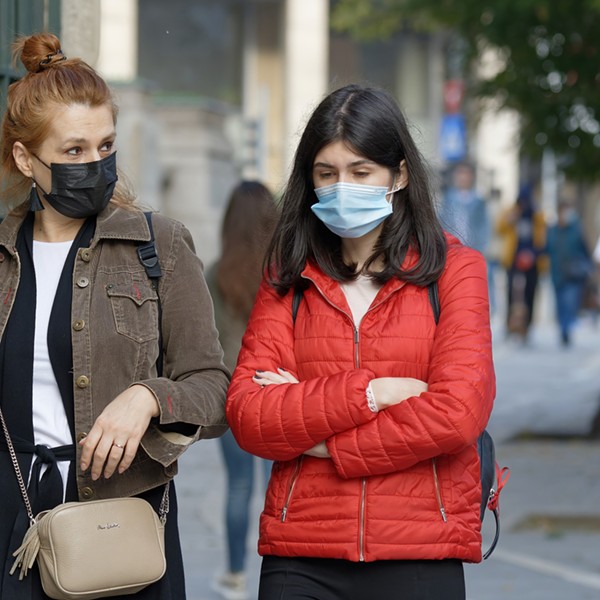After many failed attempts to stanch the flow of oil, BP used robots to cut the riser pipe and installed a new “top hat” to collect some of the oil. This has increased the flow substantially, and the company may actually be siphoning up less than the overall increase. Currently, that oil is being burned—not collected—because BP lacked the foresight to move a second tanker to the scene to hold the oil. This, despite its promise that the collected oil would be sold and the proceeds used to help wildlife. This is consistent with BP’s pattern of incompetence and pathological lying.
Here, we have a key component in the spiritual piece of this issue: the constant transaction of deception that keeps these big industries alive, and which allows them to do the damage that they do. Now, we need to investigate further and look for our own role in the problem. If we’re going to move past this, we need to figure out what this says about us.
A Change to the Natural World
In addition to the economic costs of this disaster, we are losing one of the world’s most beautiful ecosystems, as we watch. The Gulf of Mexico is a magnificent inland sea; it’s a world apart, with warm water on average less than a mile deep, and a sea floor comprised of canyons, continental shelf, reefs, and many other features. Its vast wetlands—the marshy places where land meets water, and the brackish places where river meets sea—are breeding grounds for many of the creatures who live there. Before humans arrived, the Gulf of Mexico was an aquatic paradise, and is no doubt home to numerous living relics of other epochs of history.
Every time you hear someone talk about cleaning up the Gulf of Mexico, you can be sure they have no clue. It’s one thing to shovel up sludge—that’s a cosmetic cleanup. There seems to be little effort to get the oil out of the water, and most of the booms (which are barely effective) are not being tended.
Petroleum is a concentrated toxin and water is extremely sensitive. We learned from the Exxon Valdez spill that oil is toxic to fish eggs at one part per billion. That’s like a quart of oil in 250 million gallons of seawater. A single drop can render 21,000 gallons of seawater a substance toxic to fish. We may be far past an average of one part per billion in the Gulf, and unless we distill the entire Gulf of Mexico, or those petroleum-eating microbes really work and someone uses them, we cannot get that out of the water.
Then there are the millions of gallons of dispersants (which might harm the oil-eating microbes, if anyone thinks to use them), which are toxic in themselves and which convert the oil into plumes of benzene-laced snot. These are being injected underwater for the first time in history, and are made of secret ingredients (the ingredients are proprietary), but to the best of my knowledge seem to consist of kerosene and propylene glycol. The latter has a property of sucking oxygen out of the water. A gallon of propylene glycol in seawater does the oxygen depletion damage of a million gallons of raw sewage. Countless fish in the Gulf of Mexico are dying of asphyxiation in oxygen-depleted waters.
I hate using the words millions and billions, but there are few other ways to convey the scale of the situation, or the relative toxicity of the chemicals involved. And in truth you don’t need that. You just need to imagine a dolphin with her eyes burning, or see an oil-soaked pelican, to know the truth.
BP filed fraudulent permit applications with the United States Government, and the Minerals Management Service and other agencies approved them. The application talks about protecting walruses, which are native to the Arctic. The application said there was zero chance of damage to coastlines and wildlife. BP listed a University of Florida professor who had already been dead four years as a contact in case of a spill, though claiming there was no chance of a spill happening, and no chance of oil from a rig 48 miles from shore ever reaching the coastline.
If you’re familiar with the history of the chemical industry, you know this is same old, same old. Nothing ever goes wrong, nothing ever will, and no matter how bad a chemical is, nothing is ever toxic. If people get sick, something else caused that. The places where the chemical spill happened are then decreed to be cleaner than other places. There is a word in the antichemical movement for people who get on TV and spew toxic lies: nozzleheads, a reference to the device that sprays pesticides into the air. We need a word for the people who believe these lies, because it takes two to tango.
The Emotional Dimension
If you’re into esoteric studies you have no doubt started to make the connection to what this means for the element water. Water is the element of the emotions, and much else. Now toxic material from another dimension is spewing up into the pool of our feelings. We have an image of what this says about the human condition.
There are many watery references in our current astrology. Jupiter and Uranus were in Pisces at the time of the blowout, and both will return there for a brief spell this summer. Neptune has been getting many transits lately.
And Chiron entered Pisces the very day of the blowout. Chiron last left Pisces in the late 1960s and has not been there since. Chiron calls attention to the flaws in systems, and focuses attention on whatever it touches—in this case, water. We know we have emotional issues in our culture. We know from the anger, frustration, confusion, fear, jealousy, resentment, and depression that are so representative of our culture’s emotional body. We tend to treat these issues like they don’t exist, and stuff them into the unconscious. If the truth hurts, there’s nothing like a lie to make us feel better—and that explains why we love to be lied to so much—why, indeed, we nearly insist upon it.
Now we have an uncontrolled toxic release contaminating the realm of feelings, dreams, and visions. More significantly, the sensitive, fertile meeting places where land meets water are taking the worst beating, and will take the longest to return to a position where they can sustain life. This region where land meets water is where we go for inspiration, rejuvenation, and those rare moments of relaxation. And now that space, on the Earth and in our psyches, is being fouled.
The late Ted Andrews, author of Animal Speak, said the element water is “the symbol of creation, passion and even sexuality. It is the element of all life. It is the symbol of new dimensions and new forces.” In other words, water is the breeding ground of consciousness, and represents an inner frontier. We are getting a vivid picture of the toxicity we already carry. How we are responding tells us how we respond to our own inner toxicity. Can we face the truth? Do we sink into despair? Do we give up or commence the work that needs to be done?
Totem Readings for Three Gulf of Mexico Creatures
As I witness images of struggling animals in the Gulf, I’ve wondered what their totem meanings are: that is, what they represent. The animals all have gifts and represent different parts of our human experience. I wanted to scope out this information, so I looked up in Animal Speak three of the creatures who used to thrive in the Gulf of Mexico.
Pelicans. These gorgeous, friendly, and ancient shore birds were around for 37 million years before humans arrived. Andrews says that a common misconception about pelicans is that they store food in their beaks, which is not true; their stretchy bill is like a fishing net. He suggests that when the pelican shows up, we need to consider whether we are storing something that should not be stored.
Pelicans are cooperative birds. They don’t compete for nesting grounds. They have a self-sacrificing quality. And under normal conditions, they cannot sink. They can take off and fly even when their feathers are laden with water. “Symbolically, this hints at being able to be buoyant and to rest on top in spite of the heaviness of life circumstances,” Andrews writes. “The pelican teaches us that no matter how difficult life becomes, no matter how much you plunge—you can pop up to the surface. The pelican holds the knowledge of how to rise above life’s trials.”
Turtles. We live on Turtle Island. According to Gary Snyder, this was one of the names given by the natives to North America. The earliest known turtles date from 215 million years ago. Sea turtles generally breathe air, but under dire conditions can also extract oxygen from water. They are opportunistic eaters; they eat what’s available, and thus represent our relationship to opportunity.
Andrews suggests that the turtle “unites heaven and earth” and he refers to it as the Keeper of the Doors: the gateway to the fairy realm. Because turtles live so long—some live for 80 years, and their species is one of the most ancient among reptiles—the turtle is about understanding our perception of time.
“The turtle is the symbol of the primal mother,” he writes. “To the Native Americans, the turtle was a symbol of Mother Earth and a reminder that she provides for all our needs”—if we take care of her. Because all turtles lay eggs on land, they are a link between the earthly and watery realms. In one version of the cosmic story, existence rests on the back of a turtle, who stands on the back of another turtle, and it’s turtles all the way down.
Dolphins. Dolphins, too, are world bridgers. Extremely intelligent, they are among the seafaring mammals. Like sea turtles, they live underwater and breathe air. What is interesting about dolphins is that despite their many reasons to distrust humans, they still offer us their friendship, trust, and curiosity. Many divers have been saved from shark attacks by dolphins, and Elian Gonzales, the refugee boy from Cuba, was found surrounded by them. Andrews says they represent the power of breath and sound.
“Dolphins can open new creation and dimensions to a great degree. Water is essential to life, but so is breath. Many techniques for breathing exist that teach how proper use of breath can be used to induce altered states and align oneself with new dimensions of life.”
He adds: “When you can align yourself with the dolphin through breathing you can have dolphin take you to all the places and times that existed before the great seas covered most of the world. Dolphin can lead you to underground caverns and the primordial beginnings of yourself.”
They both communicate and navigate by sound, which Andrews describes as “the creative life force. Sound came forth out of the womb of silence and created all things. Learning to create inner sounds so that you can create outer manifestations is part of what dolphin can teach.”
This is enough to give the impression that the Gulf of Mexico is like a portal to another dimension—one that is rapidly vanishing, as most of us merely watch.



















